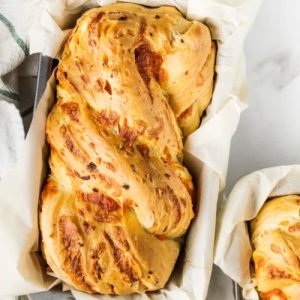
Caramelized Onion Cheddar Bread
A soft, golden loaf featuring sweet caramelized onions and melted cheddar, this bread is flavorful, fiber-rich, and perfect for sandwiches, toast, or as a side with soups and salads. Simple enough for weeknight baking yet impressive enough for sharing.
Equipment
- Medium frying pan – 1
- Large mixing bowl (1)
- Stand mixer with dough hook (optional) – 1
- Loaf pans – 2
- Sharp knife (1)
- Parchment paper (optional) – as needed
- Tea towel – 1
Ingredients
- 2¼ tsp active dry yeast
- 1⅓ cup warm water
- 1 tsp sugar
- ¼ cup milk
- 1 Tbsp olive oil plus more for onions
- 1 tsp salt
- 5 cups all-purpose flour
- 2 onions thinly sliced
- 3 cups cheddar cheese grated
- 2 tsp fresh thyme or rosemary optional
Instructions
- Caramelize the Onions: Start by preparing the onions, which are the heart of this bread’s rich flavor. Heat a generous splash of olive oil in a medium frying pan over medium heat. Add the thinly sliced onions and stir occasionally. Cook for 10–15 minutes until the onions begin to soften. Then, reduce the heat to low or medium-low depending on your stove, and allow the onions to slowly caramelize for 45 minutes. Stir every 5–10 minutes to prevent sticking or burning. You’ll notice the onions gradually turn golden brown and develop a sweet, deep flavor. Patience here is key—this slow cooking brings out the natural sugars and creates the signature taste of the bread.
- Activate the Yeast: While the onions are caramelizing, it’s time to prepare the yeast. In a large mixing bowl, combine 2¼ teaspoons of active dry yeast, 1 teaspoon of sugar, and 1⅓ cups of warm water. Make sure the water is warm but not hot—around 105–115°F (40–46°C) is ideal. Let the mixture sit for 3–4 minutes. You’ll see it begin to foam and bubble, which means the yeast is active and ready to create a light, airy dough.
- Mix the Dough: Once the yeast is foamy, add ¼ cup of milk, 1 tablespoon of olive oil, 1 teaspoon of salt, the caramelized onions, and 4 cups of flour into the bowl.Stir the mixture until it begins to form a rough dough. If the dough feels sticky, gradually sprinkle in the remaining cup of flour. Knead the dough on a floured surface or in a stand mixer with a dough hook for about 8–10 minutes, until it becomes smooth, elastic, and slightly tacky to the touch. Proper kneading develops the gluten structure, giving the bread its soft, chewy texture.
- First Rise (Proofing the Dough): Lightly oil a large clean bowl and place your dough inside. Cover it with a clean tea towel or plastic wrap and let it rise in a warm, draft-free spot. The dough should double in size, which may take 1–2 hours depending on the room temperature. For an even richer flavor, you can refrigerate the dough overnight for a slow rise, which enhances the texture and taste.
- Shape the Loaves: Once the dough has risen, gently punch it down to release the trapped air. Divide it into two equal portions. Roll each portion into a large rectangle on a lightly floured surface. Sprinkle the grated cheddar cheese evenly over the dough, along with 2 teaspoons of fresh thyme or rosemary if you’re using herbs. Starting from one short edge, carefully roll the dough into a tight “jelly roll.” This method ensures the cheese and onions are evenly distributed throughout the loaf.
- Braid the Dough: Using a sharp knife, cut each rolled dough lengthwise in half. Pinch the ends of each half together and begin braiding by crossing the strands over each other, creating a visually appealing twisted loaf. Once braided, pinch the ends to seal the dough. This braiding technique not only looks beautiful but also creates layers of cheese and onions in every bite.
- Second Rise (Final Proofing): Prepare two loaf pans by lightly greasing them or lining them with parchment paper. Gently place one braided dough in each pan.Cover with a tea towel and allow the dough to rise for a second time, about 1 hour. This final rise ensures the loaves expand fully in the oven, giving a soft, airy interior.
- Preheat the Oven: While the dough is rising, preheat your oven to 350°F (175°C).Ensuring the oven reaches the correct temperature before baking is essential for even cooking and achieving a golden crust.
- Bake the Loaves: Place the loaf pans in the oven and bake for approximately 50 minutes. Rotate the pans halfway through to ensure even baking. If you notice the top browning too quickly, move the pans to a lower rack and loosely cover the loaves with aluminum foil. The bread is done when the crust is golden brown and sounds hollow when tapped on the bottom.
- Cool and Serve: Remove the loaves from the oven and let them cool in the pans for about 5 minutes. Then transfer them to a wire rack or cutting board to cool completely. This cooling step allows the interior to set and makes slicing easier. Serve warm or at room temperature—perfect on its own, with butter, or as a sandwich base.
Notes
- For best results, caramelize the onions slowly; rushing this step will reduce sweetness and flavor.
- Use a sharp cheddar for a rich, tangy taste. Mild cheddar works too, but flavor will be subtler.
- You can substitute fresh thyme with rosemary or omit herbs entirely if preferred.
- Dough can be kneaded by hand or using a stand mixer with a dough hook.
- If the bread browns too quickly in the oven, cover loosely with aluminum foil.
- Leftover bread freezes well—slice before freezing for easy portions.
- Allow the bread to cool completely before slicing to prevent a gummy texture.